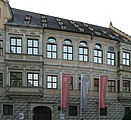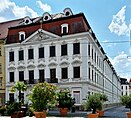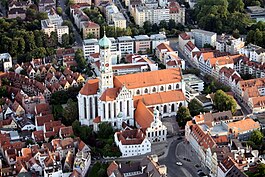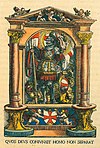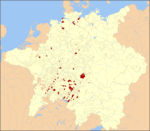Augsburg
Augsburg
Ougschburg ( Swabian) | |
|---|---|
|
From top:
and Basilica of SS. Ulrich and Afra | |
Urban district | |
| Government | |
| • Lord mayor (2020–26) | Eva Weber[1] (CSU) |
| Area | |
| • City | 146.84 km2 (56.70 sq mi) |
| Elevation | 494 m (1,621 ft) |
| Population (2022-12-31)[2] | |
| • City | 301,033 |
| • Density | 2,100/km2 (5,300/sq mi) |
| • Metro | 885,000 |
| Time zone | UTC+01:00 (CET) |
| • Summer (DST) | UTC+02:00 (CEST) |
| Postal codes | 86150–86199 |
| Dialling codes | 0821 |
| Vehicle registration | A |
| Website | www |
Augsburg (
After
In 2019 UNESCO recognised the Water Management System of Augsburg as a World Heritage Site because of its unique medieval canals and water towers and its testimony to the development of hydraulic engineering.[10]
Geography
Augsburg lies at the convergence of the
Augsburg borders the
Suburbs and neighbouring municipalities
Augsburg is surrounded by the counties Landkreis Augsburg in the west and Aichach-Friedberg in the east.
The suburbs of Augsburg are
Neighbouring municipalities: Rehling, Affing, Kissing, Mering, Merching, Bobingen, Gessertshausen.
History

Early history

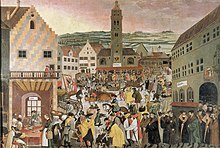
The city of Augsburg was founded in 15 BC on the orders of
Augsburg Confession
Augsburg was granted the status of a
Augsburg produced large quantities of woven goods, cloth and textiles. Augsburg became the base of two banking families that rose to great prominence, the
In 1530, the Augsburg Confession was presented to the Holy Roman Emperor at the Diet of Augsburg. Following the Peace of Augsburg in 1555, after which the rights of religious minorities in imperial cities were to be legally protected, a mixed Catholic–Protestant city council presided over a majority Protestant population; see Paritätische Reichsstadt.[16]
Leading European centre of capitalism of the sixteenth century

Augsburg's economic boom years occurred during the 15th and 16th centuries thanks to the
Augsburg's wealth attracted artists seeking
Augsburg benefitted majorly from the establishment and expansion of the
Witch hunts
Several
Thirty Years' War
Religious peace in the city was largely maintained despite increasing tensions up to the
In 1634, the Swedish army was defeated at the nearby Battle of Nördlingen. By October 1634, Catholic troops had surrounded Augsburg. The Swedish army refused to surrender and a siege ensued through the winter of 1634/35 and thousands died from hunger and disease. During the Swedish occupation and the siege by Catholic troops, the population of the city was reduced from about 70,000 to about 16,000. Diseases such as typhus and the plague ravaged the city.[25]
Guilds
In the first half of the 17th century Augsburg was pivotal in the European network of goldsmiths. Augsburg attracted goldsmith journeymen from all over Europe and in the 18th century a large number of silversmiths and goldsmiths became master craftsman in Augsburg.[26]
Nine Years' War
In 1686 the
End of Free Imperial City status


The
Industrial revolution
During the end of the 19th century, Augsburg's textile industry again rose to prominence followed by the machine manufacturing industry.[citation needed]
Second World War and Cold War
Augsburg was historically a militarily important city due to its strategic location. During the German re-armament before the Second World War, the Wehrmacht enlarged Augsburg's one original Kaserne (barracks) to three: Somme Kaserne (housing Wehrmacht Artillerie-Regiment 27); Arras Kaserne (housing Wehrmacht Infanterie Regiment 27) and Panzerjäger Kaserne (housing Panzerabwehr-Abteilung 27 (later Panzerjäger-Abteilung 27)). Wehrmacht Panzerjäger-Abteilung 27 was later moved to Füssen.
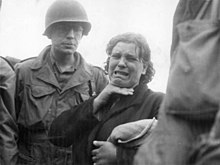
The
In 1941 Rudolf Hess, without Adolf Hitler's permission, secretly took off from a local Augsburg airport and flew to Scotland, crashing in Eaglesham, to the south of Glasgow. His objective was to meet the Duke of Hamilton in an attempt to mediate the end of the European front of World War II and join sides for the upcoming Russian Campaign.
The Reichswehr Infanterie Regiment 19 was stationed in Augsburg and became the base unit for the Wehrmacht Infanterie Regiment 40, a subsection of the Wehrmacht Infanterie Division 27 (which later became the Wehrmacht Panzerdivision 17). Elements of Wehrmacht II Battalion of Gebirgs-Jäger-Regiment 99 (especially Wehrmacht Panzerjäger Kompanie 14) was composed of parts of the Wehrmacht Infanterie Division 27. The Infanterie Regiment 40 remained in Augsburg until the end of the war, finally surrendering to the United States on 28 April 1945 when the
Following the war the three Kasernen changed hands confusingly between the American and Germans, finally ending up in US hands for the duration of the Cold War. They became the three main US barracks in Augsburg: Reese, Sheridan and FLAK. US Base FLAK had been an anti-aircraft barracks since 1936 and US Base Sheridan 'united' the former infantry barracks with a smaller Kaserne for former Luftwaffe communications units.
The American military presence in the city started with the U.S. 5th Infantry Division stationed at FLAK Kaserne from 1945 to 1955, then by
Politics
Municipality
From 1266 until 1548, the terms Stadtpfleger (head of town council) and Mayor were used interchangeably, or occasionally, simultaneously. In 1548 the title was finally fixed to Stadtpfleger, who officiated for several years and was then awarded the title for life (though no longer governing), thus resulting confusingly, in records of two or more simultaneous Stadtpfleger.
After the transfer to Bavaria in 1806, Augsburg was ruled by a Magistrate with two mayors, supported by an additional council of "Community Commissioners": the Gemeindebevollmächtige.
As of 1907, the Mayor was entitled
Mayor
The mayor of Augsburg has been Eva Weber of the Christian Social Union (CSU) since 2020. The most recent mayoral election was held on 15 March 2020, with a runoff held on 29 March, and the results were as follows:
| Candidate | Party | First round | Second round | |||
|---|---|---|---|---|---|---|
| Votes | % | Votes | % | |||
| Eva Weber | Christian Social Union | 41,534 | 43.1 | 63,762 | 62.3 | |
| Dirk Wurm | Social Democratic Party | 18,116 | 18.8 | 38,532 | 37.7 | |
| Martina Wild | Alliance 90/The Greens | 17,851 | 18.5 | |||
| Andreas Jurca | Alternative for Germany | 4,673 | 4.8 | |||
| Peter Hummel | Free Voters of Bavaria | 3,053 | 3.2 | |||
| Frederik Hintermayr | The Left | 2,564 | 2.7 | |||
| Lisa McQueen | Die PARTEI | 1,896 | 2.0 | |||
| Bruno Marcon | Augsburg in the Citizens' Hands | 1,478 | 1.5 | |||
| Anna Tabak | We are Augsburg | 1,261 | 1.3 | |||
| Lars Vollmar | Free Democratic Party | 1,249 | 1.3 | |||
| Christian Pettinger | Ecological Democratic Party | 1,183 | 1.2 | |||
| Claudia Eberle | Pro Augsburg | 941 | 1.0 | |||
| Florian Betz | V-Partei³
|
678 | 0.7 | |||
| Valid votes | 96,477 | 99.4 | 102,294 | 99.4 | ||
| Invalid votes | 578 | 0.6 | 661 | 0.6 | ||
| Total | 97,055 | 100.0 | 102,955 | 100.0 | ||
| Electorate/voter turnout | 214,110 | 45.3 | 213,982 | 48.1 | ||
| Source: City of Augsburg (first round, second round) | ||||||
City council

The Augsburg city council governs the city alongside the Mayor. The most recent city council election was held on 15 March 2020, and the results were as follows:
| Party | Votes | % | +/- | Seats | +/- | |
|---|---|---|---|---|---|---|
| Christian Social Union (CSU) | 1,653,781 | 32.3 | 20 | |||
| Alliance 90/The Greens (Grüne) | 1,198,090 | 23.4 | 14 | |||
| Social Democratic Party (SPD) | 734,066 | 14.3 | 9 | |||
| Alternative for Germany (AfD) | 337,834 | 6.6 | 4 | ±0 | ||
| Free Voters of Bavaria (FW) | 230,952 | 4.5 | 3 | |||
| The Left (Die Linke) | 189,034 | 3.7 | 2 | ±0 | ||
| Free Democratic Party (FDP) | 117,201 | 2.3 | 1 | ±0 | ||
| Ecological Democratic Party (ÖDP) | 114,119 | 2.2 | 1 | ±0 | ||
| Generation AUX (GenAUX) | 108,956 | 2.1 | New | 1 | New | |
| Augsburg in the Citizens' Hands (AiB) | 96,690 | 1.9 | New | 1 | New | |
| Pro Augsburg (PRO A) | 94,346 | 1.8 | 1 | |||
| We are Augsburg (WSA) | 77,189 | 1.5 | New | 1 | New | |
| Die PARTEI | 76,557 | 1.5 | New | 1 | New | |
V-Partei³
|
69,643 | 1.4 | New | 1 | New | |
| Political Voters' Association/Democracy in Motion (Polit-WG/DiB) | 29,149 | 0.6 | 0 | |||
| Total | 5,127,607 | 100.0 | ||||
| Invalid votes | 2,079 | 2.1 | ||||
| Total | 97,013 | 100.0 | 60 | ±0 | ||
| Electorate/voter turnout | 214,110 | 45.3 | ||||
| Source: City of Augsburg | ||||||
Members of the Bundestag
Augsburg is located in the Wahlkreis 253 Augsburg-Stadt constituency, which includes Königsbrunn and parts of the District of Augsburg (Landkreis Augsburg).
Indirectly elected to the Bundestag to adhere to the
Climate
Augsburg has an oceanic climate (Köppen climate classification: Cfb) or, following the 0 °C isotherm, a humid continental climate (Dfb).
| Climate data for Augsburg (1991–2020 normals) | |||||||||||||
|---|---|---|---|---|---|---|---|---|---|---|---|---|---|
| Month | Jan | Feb | Mar | Apr | May | Jun | Jul | Aug | Sep | Oct | Nov | Dec | Year |
| Mean daily maximum °C (°F) | 3.0 (37.4) |
4.8 (40.6) |
9.5 (49.1) |
14.5 (58.1) |
18.8 (65.8) |
22.2 (72.0) |
24.2 (75.6) |
24.1 (75.4) |
19.1 (66.4) |
13.6 (56.5) |
7.1 (44.8) |
3.7 (38.7) |
13.7 (56.7) |
| Daily mean °C (°F) | −0.1 (31.8) |
0.7 (33.3) |
4.4 (39.9) |
8.8 (47.8) |
13.2 (55.8) |
16.6 (61.9) |
18.3 (64.9) |
18.0 (64.4) |
13.4 (56.1) |
8.9 (48.0) |
3.9 (39.0) |
0.8 (33.4) |
8.9 (48.0) |
| Mean daily minimum °C (°F) | −3.2 (26.2) |
−3.2 (26.2) |
−0.3 (31.5) |
2.8 (37.0) |
7.2 (45.0) |
10.7 (51.3) |
12.2 (54.0) |
11.9 (53.4) |
8.0 (46.4) |
4.6 (40.3) |
0.7 (33.3) |
−2.2 (28.0) |
4.1 (39.4) |
| Average precipitation mm (inches) | 45.1 (1.78) |
34.1 (1.34) |
47.3 (1.86) |
45.8 (1.80) |
84.8 (3.34) |
92.0 (3.62) |
94.3 (3.71) |
91.8 (3.61) |
61.9 (2.44) |
52.9 (2.08) |
50.2 (1.98) |
49.7 (1.96) |
749.4 (29.50) |
| Average precipitation days (≥ 0.1 mm) | 14.9 | 14.2 | 14.8 | 12.4 | 14.7 | 16.0 | 15.4 | 14.2 | 13.2 | 14.3 | 14.4 | 16.8 | 175.3 |
| Average snowy days (≥ 1.0 cm) | 10.8 | 10.1 | 3.7 | 0.3 | 0 | 0 | 0 | 0 | 0 | 0.1 | 2.7 | 7.4 | 38.1 |
| Average relative humidity (%)
|
86.2 | 82.5 | 78.0 | 72.5 | 72.9 | 73.8 | 73.4 | 74.9 | 81.1 | 85.5 | 89.2 | 88.2 | 79.8 |
| Mean monthly sunshine hours | 61.8 | 88.1 | 138.3 | 186.4 | 211.9 | 228.0 | 243.8 | 230.2 | 162.8 | 106.6 | 55.9 | 54.1 | 1,768.5 |
| Source: NOAA[31]
| |||||||||||||
Main sights



- Town Hall, built in 1620 in the Renaissance style with the Goldener Saal
- Perlachturm, a bell tower built in 989
- Fuggerei, the oldest social housing estate in the world, inhabited since 1523
- Fuggerhäuser (Fugger houses), restored renaissance palatial homes of the Fugger banking family
- Bishop's Residence, built about 1750 in order to replace the older bishop's palace; today the administrative seat of Swabia
- Cathedral, founded in the ninth century
- St Anne's Church, medieval church building that was originally part of a monastery built in 1321
- St Mary's Syriac Orthodox Church on the Zusamstraße in Lechhausen, built 1998 by Suryoye (Assyrians)
- Augsburg Synagogue, one of the few German synagogues to survive the war, now restored and open with a Jewish museum inside
- Augsburg textile and industry museum- or just tim - organises its displays under headings Mensch-Maschine-Muster-Mode.
- Schaezlerpalais, a Rococo mansion (1765) now housing a major art museum
- St Ulrich and St Afra— one church is Roman Catholic, the other Lutheran, the duality being a result of the Peace of Augsburg concluded in 1555 between Catholics and Protestants
- Mozart Haus Augsburg (where the composer's father Leopold Mozart was born and Mozart visited several times)
- Augsburger Puppenkiste, a puppet theatre
- Luther Stiege, museum located in a church that showing Martin Luther's life and various rooms. (free admission)
- Eiskanal, the world's first artificial whitewatercourse (venue for the whitewater events of the 1972 Munich Olympics)
- Dorint Hotel Tower
- Childhood home of Bertolt Brecht
- The Augsburg Botanical Gardens (Botanischer Garten Augsburg)
- Maximillian Museum, decorative arts
- Bahnpark Augsburghome of 29 historic locomotives, blacksmith, historic roundhouse
- 3 magnificent renaissance fountains, the Augustus Fountain, Mercury Fountain and Hercules Fountain from the 15th century, built for the 1500th anniversary of the foundation of the city
- Walter Art Museum at the Glas Palast ("Glas-Palace")
- Roman Museum in the former Monastery of St Magdalena. In December 2012 the church was closed owing to the risk of collapse. In 2015 an exhibition opened in the Zeughaus, which will replace the museum for an indefinite period. Renovation work is ongoing and the Church will remain closed until further notice.[32]
- Medieval canals, used to run numerous industries, medieval arms production, silver art, sanitation and water pumping
- Kulturhaus Abraxas
-
Fünfgratturm tower
-
Ring of Mercy on the Dom (Cathedral) St Maria
-
Augsburg Synagogue
-
St. Ulrich and St. Afra Cathedral
-
Plaque commemorating the Joint Declaration on the Doctrine of Justification at St. Anne's Church
Water Management System
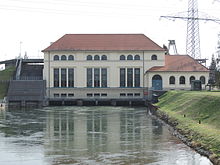
The water systems of Augsburg have been the site of innovations in hydraulic engineering for centuries.[33] Augsburg was built on top of an aquifer fed by the Lech and Wertach rivers, which provided purified groundwater that ran through the city through springs and streams.[34] The canals channelling this water through the city were first mentioned in 1276, and by 1416 waterworks, pumps and water towers were added to distribute this water effectively.[34] In 1545 Augsburg was one of the first European towns to separate drinking water from water used for industry, effectively preventing water-borne diseases.[10] The pumps and waterwheels also generated power for fountains and food processing, such as a 17th-century butcher's hall that still stands today.[34] In the 19th and 20th centuries hydroelectic power plants were also installed. These power plants were some of the first in the world to generate electricity from water and they are still in use today.[34] On 6 July 2019 the Water Management System of Augsburg was designated as a UNESCO World Heritage Site.[35]
Incorporations
| Year | Municipality | Area |
|---|---|---|
| 1 July 1910 | Meringerau | 9.5 km2 |
| 1 January 1911 | Pfersee | 3.5 km2 |
| 1 January 1911 | Oberhausen | 8.6 km2 |
| 1 January 1913 | Lechhausen | 27.9 km2 |
| 1 January 1913 | Hochzoll |
4.4 km2 |
| 1 April 1916 | Kriegshaber | 59 km2 |
| 1 July 1972 | Göggingen | |
| 1 July 1972 | Haunstetten |
|
| 1 July 1972 | Inningen |
Population
| Year | Pop. | ±% |
|---|---|---|
| 1635 | 16,432 | — |
| 1645 | 19,960 | +21.5% |
| 1806 | 26,200 | +31.3% |
| 1830 | 29,019 | +10.8% |
| 1871 | 51,220 | +76.5% |
| 1890 | 75,629 | +47.7% |
| 1900 | 89,109 | +17.8% |
| 1910 | 102,487 | +15.0% |
| 1916 | 146,226 | +42.7% |
| 1925 | 165,522 | +13.2% |
| 1933 | 176,575 | +6.7% |
| 1939 | 185,369 | +5.0% |
| 1945 | 146,416 | −21.0% |
| 1950 | 185,183 | +26.5% |
| 1961 | 208,659 | +12.7% |
| 1970 | 211,566 | +1.4% |
| 1975 | 252,000 | +19.1% |
| 1980 | 246,600 | −2.1% |
| 1985 | 244,200 | −1.0% |
| 1990 | 256,877 | +5.2% |
| 1995 | 259,699 | +1.1% |
| 2000 | 254,982 | −1.8% |
| 2005 | 262,676 | +3.0% |
| 2010 | 264,708 | +0.8% |
| 2015 | 281,111 | +6.2% |
| 2019 | 296,582 | +5.5% |
| Population size may be affected by changes in administrative divisions. | ||
Augsburg has a population of about 300,000. It is the third largest city in Bavaria and the largest city in the Swabia region. In the 16th century, Augsburg was one of the largest cities in Holy Roman Empire, with a population of about 30,000. This put it on a level with cities like Cologne and Prague. Augsburg passed 100,000 residents in 1909 and the population has grown steadily since then.
| Largest groups of foreign residents[36] | |
| Nationality | Population (31 December 2022) |
|---|---|
| 11,701 | |
| 7,242 | |
| 5,382 | |
| 4,280 | |
| 4,123 | |
| 2,581 | |
| 2,332 | |
| 2,249 | |
| 2,169 | |
| 2,107 | |
| 1,823 | |
| 1,650 | |
Twin towns – sister cities
Transport
Roads
The main road link is autobahn A 8 between Munich and Stuttgart.
Public transport
Public transport is very well catered for. It is controlled by the Augsburger Verkehrs- und Tarifverbund (Augsburg transport and tariff association, AVV) extended over central Swabia. There are seven rail Regionalbahn lines, five tram lines, 27 city bus lines and six night bus lines, as well as several taxi companies.
The Augsburg tramway network is now 35.5 km-long after the opening of new lines to the university in 1996, the northern city boundary in 2001 and to the Klinikum Augsburg (Augsburg hospital) in 2002. Tram line 6, which runs 5.2 km from Friedberg West to Hauptbahnhof (Central Station), opened in December 2010.[38]
Intercity bus
There is one station for intercity bus services in Augsburg: Augsburg Nord, located in the north of the city.[39]
Railway

Augsburg has seven stations, the
The AVV operates seven Regionalbahn lines from the main station to:
- Mammendorf
- Schmiechen (direction to Ammersee)
- Aichach/Radersdorf
- Meitingen/Donauwörth
- Dinkelscherben
- Schwabmünchen
- Klosterlechfeld
Starting in 2008, the regional services are planned to be altered to S-Bahn frequencies and developed long term as integrated into the Augsburg S-Bahn.
Air transport
Until 2005 Augsburg was served by nearby Augsburg Airport (AGB). In that year all air passenger transport was relocated to Munich Airport. Since then, the airport is used almost entirely by business airplanes.[40]
Economy

Augsburg is a vibrant industrial city. Many global market leaders namely
Major companies
- Boewe Systec[42]
- Faurecia
- Fujitsu Technology Solutions
- KUKA Robotics / Systems
- MAN (Maschinenfabrik Augsburg-Nürnberg)
- manroland
- MT-Aerospace (former MAN Technologie)
- NCR
- Osram
- Premium AEROTEC
- RENK AG (offshoot of MAN SE)
- Siemens
- UPM-Kymmene(former Haindl)
- WashTec (former Kleindienst)
- Synlab Group
- Cancom
- Check24
- Amazon
- Patrizia Immobilien
Education
Augsburg is home to the following universities and colleges:
- University of Augsburg, founded in 1970[43]
- Technische Hochschule Augsburg (University of Applied Sciences, formerly Fachhochschule Augsburg)
Media
The local newspaper is the Augsburger Allgemeine first published in 1807.[citation needed]
Notable people

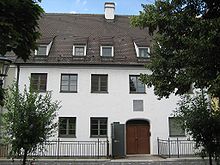



- Saint Afra, (died 304), patron Saint of Augsburg, martyr
- Simpert, (died 807), abbot, bishop and confessor
- Saint Ulrich (c. 890–973), Prince-Bishopric of Augsburg
- Saint Wolfhard (1070–1127), Swabian artisan, trader and hermit
- Jakob Fugger the Elder (1398–1469), master weaver, town councillor and merchant[44]
- Erhard Ratdolt (1442–1528), Printer, famous for having produced the first known printers type specimen book
- Jakob Fugger (1459–1525), Noted banker and financial broker. An area within the city, called the Fuggerei, was set aside for the poor and needy in 1519.[44]
- Hans Holbein the Elder (1460–1524), pioneer in the transformation of German art from the Gothic to the Renaissance style[45]
- Konrad Peutinger (1465–1547), humanist, jurist, diplomat, politician, economist and archaeologist[46]
- Hans Burgkmair (1473–1531), painter and woodcut printmaker[47]
- Caspar Aquila (1488–1560), Lutheran theologian and reformer[48]
- Hans Holbein the Younger (1497–1543), portrait and religious painter[49]
- Matthäus Schwarz (1497–c. 1574), accountant and author
- Paulus Hector Mair (1517–1579), martial artist
- Wilhelm Xylander (1532–1576), classical scholar and humanist[50]
- Elias Holl (1573–1646), architect
- Philipp Hainhofer (1578–1647), merchant, banker, diplomat and art collector
- Julius Schiller (1580–1627), lawyer and astronomer
- Johann Georg Wirsung (1589–1643), anatomist
- Johann Jakob Brucker (1696–1770), German historian of philosophy[51]
- Andreas Christoph Graf (1701–1776), German teacher, author and poet
- Johann Jakob Haid(1704–1767), engraver
- Leopold Mozart (1719–1787), violinist-composer, father of Wolfgang Amadeus Mozart
- Christoph Christian Sturm (1740–1786), preacher and author
- Eduard Bayer (1822–1908), composer and classical guitarist
- Emil Schürer (1844–1910), Protestant theologian. He studied the history of the Jews.[52]
- Johann Most (1846–1906), Social Democratic and then anarchist politician, newspaper editor and orator[53]
- Rudolf Diesel (1858–1913), inventor of the diesel engine
- Albert Rehm (1871–1949), philologist who first understood the significance of the Antikythera mechanism
- Hans von Euler-Chelpin (1873–1964), co-recipient of 1929 Nobel Prize in Chemistry
- Karl Haberstock (1878–1956), art dealer to the Nazis
- Artur Lauinger (1879–1961), German journalist
- Julius Streicher (1885–1946), prominent Nazi prior to World War II, founder and publisher of anti-Semitic Der Stürmer newspaper, executed for war crimes
- Julius Schaxel (1887–1943), biologist
- Hans Loritz (1895–1946), Nazi SS concentration camp commandant
- Bertolt Brecht (1898–1956), writer and theater director
- August Schmidhuber (1901–1947), Nazi SS officer, executed for war crimes
- Wilhelm Gerstenmeier (1908–1944), SS concentration camp officer, executed for war crimes
- Josef Priller (1915–1961), Luftwaffe ace
- Mietek Pemper (1920–2011), Polish-born Jew. He compiled and typed Oskar Schindler's list, which saved 1,200 Jewish prisoners from the Holocaust.[54][55]
- Günther Schneider-Siemssen (1926–2015), scenic designer
- Hans Henning Atrott (1944–2018), German author and theorist
- Wolf Blitzer (born 1948), American journalist and CNN reporter
- Francis T. McAndrew (born 1953), American Psychologist, Professor, and Author (U.S. military parents)
- Günther K.H. Zupanc (born 1958), neurobiologist, researcher, university teacher, book author, journal editor and educational reformer
- Sheryl Lee (born 1967), actress, poet and activist
- Alexander Wesselsky (born 1968), lead singer of the German band Eisbrecher
- Florian Hecker (born 1975), experimental electronic music composer
- Marisa Olson (born 1977), artist
- Benny Greb (born 1980), solo drum artist
- Andreas Bourani (born 1983), singer-songwriter
- Bianca Voitek (born 1985), female bodybuilder
- Maximilian Hornung (born 1986), cellist
Sport

- Werner Haas (1927–1956), Grand Prix motorcycle road racer
- Ulrich Biesinger (1933–2011), former German footballer, part of the team that won the 1954 FIFA World Cup
- Helmut Haller (1939–2012), footballer who represented West Germany at three World Cups
- Bernhard Langer (born 1957), professional golfer
- Bernd Schuster (born 1959), football coach and former player
- Armin Veh (born 1961), football coach
- Alexander Grau (born 1973), racing driver
- Philipp Kohlschreiber (born 1983), former tennis player
- Thomas Holzer (born 1985), racing driver
- Stefan Bradl (born 1989), motorcycle racer
- Johnny Cecotto Jr. (born 1989), racing driver
- Phoenix Sanders (born 1995), American baseball pitcher in the San Francisco Giants organisation
- Nico Sturm (born 1995), ice hockey player
Sports

FC Augsburg is a football team based in Augsburg and plays in the WWK ARENA to the south of the city centre. FC Augsburg secured promotion to Bundesliga in 2011 and have remained there ever since, qualifying for the Europa League for the first time in 2015 and securing mid-table finishes across the last few seasons. The club, nicknamed the Fuggerstädter or simply as FCA, reached the last 32 in the 2015–16 Europa League with a 1–0 aggregate defeat to Liverpool. The WWK ARENA, nicknamed the "Anfield of the B17 Highway" following the Liverpool UEL match, opened in July 2009 and also hosted games of the 2011 FIFA Women's World Cup. The 30,660 capacity arena is easily accessible from the city centre or the adjacent B17 dual carriageway.
The city is home to a DEL (first-division) ice hockey team, the Augsburger Panther. The original club, AEV, was formed in 1878, the oldest German ice sport club and regularly draws around 4,000 spectators, quite reasonable for German ice hockey. Home games are played at the Curt Frenzel Stadion: a recently rebuilt (2012–2013) indoor rink and modern stadium and the club reached the 2018/19 DEL semi finals, eventually losing in the winner-takes-all game 7 to EHC Red Bull München (4–3 series defeat). Consequently, the Panthers qualified for the Champions Hockey League. Augsburg is also home to one of the most traditional German Baseball clubs, the Augsburg Gators and 2 American Football Clubs, the Raptors and Augsburg Storm, and in nearby Königsbrunn there is the Königsbrunn Ants.
For the 1972 Olympic Games in Munich, a protective diversion channel of the Lech dam for river ice was transformed into the world's first artificial whitewater slalom course: the Eiskanal, which remains a world-class competition venue and has served as a prototype for two dozen similar courses abroad.
Local city nicknames
While commonly called Fuggerstadt (Fuggers' city) due to the Fuggers residing there, within Swabia it is also often referred to as Datschiburg: which originated sometime in the 19th century refers to Augsburg's favorite sweet: the Datschi made from fruit, preferably prunes, and thin cake dough.[56] The Datschiburger Kickers charity football team (founded in 1965) reflects this in its choice of team name.[57][58]
Among younger people, the city is commonly called "Aux" for short. [citation needed]
See also
- Lutheran College in Minneapolis, Minnesota (USA) that takes its name from the Augsburg Confession
- League of Augsburg
- List of civic divisions of Augsburg
- List of mayors of Augsburg
- Synods of Augsburg
Notes
- Bayerisches Landesamt für Statistik, accessed 19 July 2021.
- ^ Genesis Online-Datenbank des Bayerischen Landesamtes für Statistik Tabelle 12411-003r Fortschreibung des Bevölkerungsstandes: Gemeinden, Stichtag (Einwohnerzahlen auf Grundlage des Zensus 2011) (Hilfe dazu).
- ^ "Augsburg". Lexico UK English Dictionary. Oxford University Press. Archived from the original on 11 March 2020.
- ^ "Augsburg". Merriam-Webster.com Dictionary. Retrieved 12 August 2019.
- ^ Koristka, Thomas (22 February 2023). "Neuer Einwohnerrekord: Augsburg reißt (wieder) die 300.000er-Marke". Hallo Augsburg (in German). Archived from the original on 15 March 2024. Retrieved 12 July 2023.
- ^ "Und-wieder-5000-Menschen-mehr-Augsburg-waechst-und-waechst". www.augsburger-allgemeine.de. 17 February 2015. Archived from the original on 27 February 2015. Retrieved 28 February 2015.
- ^ Behringer 2011, p. 350.
- ^ Rollenhagen, L., Germany's Fuggerei is world's oldest social housing project, 2024, Deutsche Welle
- ^ Billock, J., After Almost 500 Years, the World’s Oldest Social Housing Complex Is Still Going Strong, Smithsonian Magazine, 2024
- ^ a b "Water Management System of Augsburg". UNESCO World Heritage Centre. United Nations Educational, Scientific, and Cultural Organization. Archived from the original on 6 October 2020. Retrieved 1 October 2022.
- ISBN 978-0-387-89684-7. Archivedfrom the original on 15 March 2024. Retrieved 10 May 2018.
- ISBN 9781848221222.
- ISBN 9780191622656.
- ISBN 9781848221222.
- ^ "After Almost 500 Years, the World's Oldest Social Housing Complex is Still Going Strong". Archived from the original on 31 March 2022. Retrieved 17 September 2021.
- ^ Mark, Joshua J. (26 January 2022). "Augsburg Confession". World History Encyclopedia. Archived from the original on 26 April 2023. Retrieved 26 April 2023.
- ISBN 978-1-78308-387-9. Archivedfrom the original on 15 March 2024. Retrieved 7 August 2022.
- ISBN 978-88-00-72230-8. Archivedfrom the original on 15 March 2024. Retrieved 7 August 2022.
- ISBN 9781603849203.
- ^ "Leopold Mozart: Biography & History". allmusic.com. Archived from the original on 9 July 2017. Retrieved 24 February 2017.
- ISBN 978-3-11-045673-8. Archivedfrom the original on 2 July 2023. Retrieved 7 February 2022.
- ISBN 9783642543319. Archivedfrom the original on 26 September 2021. Retrieved 20 September 2021.
- ISBN 9780199602971. Archived(PDF) from the original on 9 October 2022. Retrieved 7 August 2022.
- ISBN 9780521525107.
- ISBN 1851096582.
- ISBN 9781139471077.
- ISBN 0-691-00685-7, page 183
- ^ Edward Victor. Alphabetical List of Camps, Subcamps and Other Camps. "List of Camps". Archived from the original on 16 December 2010. Retrieved 25 July 2008.
- ^ "Campaign Diary February 1944". Royal Air Force Bomber Command 60th Anniversary. UK Crown. Archived from the original on 6 July 2007. Retrieved 7 December 2014.
- ^ ePaper 14. January 2014: Results of the Bundestagswahl 2014 in Augsburg Archived 23 September 2015 at the Wayback Machine (PDF; 12,1 MB)
- ^ "Augsburg Climate Normals 1991–2020". National Oceanic and Atmospheric Administration. Archived from the original on 14 September 2023. Retrieved 15 September 2023.
- ^ "Römisches Museum". kunstsammlungen-museen.augsburg.de. 2023. Archived from the original on 1 March 2023. Retrieved 1 March 2023.
- ^ James Douet (2018). "The Water Industry as World Heritage" (PDF). The International Committee for the Conservation of the Industrial Heritage (TICCIH). p. 32. Archived (PDF) from the original on 9 October 2022.
- ^ a b c d Water Management System of Augsberg (Germany), No. 1580 (Report). ICOMOS. 13 March 2019. Archived from the original on 3 August 2022. Retrieved 1 October 2022.
- ^ "Seven more cultural sites added to UNESCO's World Heritage List". UNESCO. 6 July 2019. Archived from the original on 7 March 2020. Retrieved 6 July 2019.
- ^ "Strukturdaten nach Stadtbezirk" (PDF). Archived from the original (PDF) on 27 April 2019. Retrieved 25 June 2018.
- ^ "Augsburgs Partnerstädte – Freundschaften und Begegnungen auf drei Kontinenten". augsburg.de (in German). Augsburg. Archived from the original on 19 June 2022. Retrieved 4 November 2020.
- ^ "Railway Gazette: Urban rail news in brief". Archived from the original on 1 January 2011. Retrieved 2 January 2011.
- ^ "Augsburg: Stations". Travelinho.com. Archived from the original on 4 August 2020. Retrieved 2 December 2017.
- ^ "Augsburg Airport (EDMA)". flughafen-augsburg.de. Archived from the original on 1 April 2016. Retrieved 24 February 2017.
- ^ "Verordnung zur Änderung der Verordnung über das Landesentwicklungsprogramm Bayern" (PDF). Bayerisches Staatsministerium der Finanzen, für Landesentwicklung und Heimat. 21 February 2018. Archived from the original (PDF) on 18 July 2018. Retrieved 18 July 2018.
- ^ "BÖWE SYSTEC GmbH | Kuvertiersysteme, Kartenversandsysteme, Sortieranlagen, Lesetechnologie und Software". boewe-systec.com. Archived from the original on 18 April 2018. Retrieved 24 February 2017.
- ^ "Universität Augsburg". uni-augsburg.de. Archived from the original on 29 July 2019. Retrieved 24 February 2017.
- ^ a b . Encyclopædia Britannica. Vol. 11 (11th ed.). 1911. pp. 287–288.
- ^ . Encyclopædia Britannica. Vol. 13 (11th ed.). 1911. pp. 577–578.
- ^ . Encyclopædia Britannica. Vol. 21 (11th ed.). 1911. p. 338.
- ^ . Encyclopædia Britannica. Vol. 4 (11th ed.). 1911. p. 817.
- ^ . Encyclopædia Britannica. Vol. 2 (11th ed.). 1911. pp. 248–249.
- ^ Crowe, Joseph Archer (1911). . Encyclopædia Britannica. Vol. 13 (11th ed.). pp. 578–580.
- ^ . Encyclopædia Britannica. Vol. 28 (11th ed.). 1911. p. 889.
- ^ . Encyclopædia Britannica. Vol. 4 (11th ed.). 1911. pp. 677–678.
- ^ . Encyclopædia Britannica. Vol. 24 (11th ed.). 1911. p. 386.
- ^ . Encyclopædia Britannica. Vol. 18 (11th ed.). 1911. p. 903.
- ^ "Oskar Schindler's collaborator, Mietek Pemper, has died". Agence France-Presse. The Gazette (Montreal). 15 June 2011. Retrieved 26 June 2011.[permanent dead link]
- ^ Martin, Douglas (18 June 2011). "Mietek Pemper, 91, Camp Inmate Who Compiled Schindler's List". The New York Times. Archived from the original on 23 June 2011. Retrieved 26 June 2011.
- ^ Augsburger Stadtlexikon – Datschiburg Archived 19 July 2011 at the Wayback Machine (in German) accessed: 18 November 2008
- ^ Datschiburger Kickers website Archived 6 October 2009 at the Wayback Machine accessed: 18 November 2008
- ^ Augsburger Stadtlexikon – Datschiburger Kickers Archived 19 July 2011 at the Wayback Machine (in German) accessed: 18 November 2008
References
- Die Chroniken der schwäbischen Städte, Augsburg, (Leipzig, 1865–1896).
- Werner, Geschichte der Stadt Augsburg, (Augsburg, 1900).
- Lewis, "The Roman Antiquities of Augsburg and Ratisbon", in volume xlviii, Archæological Journal, (London, 1891).
- Michael Schulze, Augsburg in one day. A city tour Lehmstedt Verlag, Leipzig 2015, ISBN 978-3957970176.
Bibliography
External links
- Stadt Augsburg Official site (English version)
- Augsburg Tourism Official tourism portal for Augsburg region
- (in German) Augsburg City Plan
- (in German) District of Augsburg
- Hydraulic Engineering and Hydropower, Drinking Water and Decorative Fountains in Augsburg Archived 6 July 2019 at the Wayback Machine


